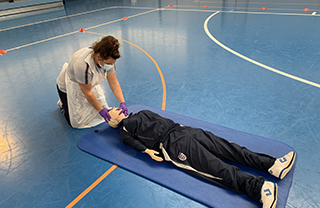
Guidance for first aid in football during COVID-19
- The Boot Room
- 04 August 2020
The current COVID-19 situation has changed how first aid in football can and should be approached. Below, Dr Lisa Hodgson, The FA's medical education lead, takes us through the updated guidance.
This information is designed to raise awareness and keep our trained first aiders, coaches, clubs and players safe during this global pandemic. It will be updated as government guidelines change, so make sure you return to this page on a regular basis.
This guidance is currently specific to outdoor football activities and you can find a range of downloadable resources and links at the bottom of the page, including guides for returning to football for both the grassroots and the professional game.
Further details can be found in resources at the bottom of this page. The FA's first aid guidance for returning to outdoor competitive grassroots football document includes guidelines for personal hygiene, which are also available here: Handwashing with soap and Handwashing with gel.
The vast majority of incidents you'll encounter on the football pitch can be managed without the need to get close to a player, where you would risk coming into contact with cough droplets. Sensible precautions will ensure you’re able to treat a player effectively without compromising social distances.
But what do you do if you are required to come into close contact with someone as part of your first responder duties? Watch the video below to find out more. (Please note, that at this time first aid should only be provided for emergency situations and should not include management for any chronic conditions – those should be handled by a player's own GP.)
The safety of the responder is paramount and no-one is expected to provide care which jeopardises their own personal health or safety. In an emergency situation, where suitable personal protective equipment (PPE) is not available, the responder must consider the potential risks (to both themselves and the player) and decide what level of care they feel is reasonable – or what level of care they’re able to provide in the absence of PPE. This may include providing no assistance at all until the ambulance arrives or until appropriate PPE is made available.
Clubs are requested to conduct their own risk assessments considering amendments with the addition of PPE and donning times before any mitigation is made. No decision to reduce PPE should ever impact negatively on the care provided, or the ability to deliver timely care in an emergency situation.
For further information, please watch this Public Health England video about putting on and removing PPE.
Next up, let's look at what you should do if a player develops COVID-19 symptoms during a training session or match:
SCA is a recognised medical emergency that can occur in football, further complicated by cardiac involvement being recognised as a complication of COVID-19. It’s critical that each club includes this in their risk assessment, carefully consider updated precautions for this period, and adopt any appropriate recommended provisions before returning to training or playing.
This guidance is presented in more depth in the document: First aid guidance for returning to outdoor competitive grassroots football. Please ensure you read the document as well as watching this video.
Any player who has had COVID-19 symptoms should be cleared by their own doctor before returning to training. As an absolute minimum those players who've had symptoms lasting more than seven days during their illness, even if asymptomatic at the time of returning to football, should have full medical clearance before returning to training. If symptoms resume, or players feel unwell or have persistent tiredness on return to training, they should consult their own doctor again.
After performing compression-only CPR, all rescuers should wash their hands – and their face unless a mask or eye protection was worn – thoroughly with soap and water; or alcohol-based hand gel as a convenient alternative. They should also seek advice from the NHS 111 coronavirus advice service and their club medical adviser if they’re concerned about COVID-19 symptoms.
For a reminder of how to deal with a sudden cardiac arrest in a non-COVID-19 situation, complete The FA Sudden Cardiac Arrest online module.
When managing concussion and other football-related injuries during COVID-19, medical kits should have additional PPE to allow for regular replacement of any single use items.
Where there is social distancing and no face-to-face contact, a first aider can wear minimal PPE (so a fluid resistant Type IIR mask) and direct family members from a social distanced position in how to assist an injured player.
Other players will still need to socially distance unless a life or limb-threatening injury necessitates compromising guidelines to provide emergency care until the ambulance arrives.
In the video below, we'll look at first aid for other football-related injuries where social distance needs to be compromised.
To refresh yourself on how to deal with a concussion, in a non-COVID-19 environment, go to: The FA Concussion Guidelines.
If you want further information and medical guidance, take a look at the documents and links below:
- The FA's first aid guidance for returning to outdoor competitive grassroots football
- First aid guidance checklist
- Handwashing with soap
- Handwashing with gel
- The FA elite framework for return to sport
- Donning and doffing standard Personal Protective Equipment (PPE)
- PPE use for non-aerosol generating procedures
- Decontamination in non-healthcare settings
- FA 11-point summary of main Step 4 guidance – 20 August
- Football activity master guidance for re-starting outdoor grassroots football – 20 August
- COVID-19 safeguarding risk assessment guidance – 16 July
- National League System club guidance – 16 July
- Women’s football pyramid club guidance – 16 July


